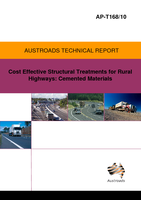Pavement

- Publication no: AP-T168-10
- ISBN: 978-1-921709-41-8
- Published: 25 October 2010
- PDF (free) Download
This report describes the preparation, testing and results from project TT1358: Cost-effective structural treatments for rural highways: Cemented Materials. Ten granular materials, with a variety of different characteristics such as normal to high fines content or low to high plasticity, were selected and mixed with different cement contents. In addition, two lean mix concretes were prepared. Flexural beams were manufactured and tested for modulus, flexural strength, breaking strains and fatigue.
Analysis of the flexural fatigue results found that relationships that incorporate strain rather than stress were statistically more significant in terms of their ability to explain the observed data. In addition, the analysis indicated that material modulus was not a significant factor affecting fatigue life other than the influence on strains developed under an applied load. It was found that breaking strain (ε b, in this study defined as strain at 95% breaking load from flexural strength testing), is a significant variable influencing the fatigue life of cemented materials. In addition, the ratio of initial strain (ε i, from the flexural fatigue test) divided by breaking strain (from the flexural strength test) was able to explain a substantial amount of the differences in fatigue characteristics between materials. It was concluded that strain ratio (ε i/ε b) is seen as a potentially superior method of incorporating material quality into the cemented materials design relationship compared with the modulus dependency included in the current Austroads relationship.
- Cost Effective Structural Treatments for Rural Highways: Cemented Materials
- Austroads membership
- 1. INTRODUCTION
- 2. PROJECT BACKGROUND
- 2.1. Fatigue Phases of Cemented Materials
- 2.2. Fatigue Distress Mechanisms of Cemented Materials
- 2.2.1. Influence of Microstructure
- 2.2.2. Relationships between Cemented Material Properties
- 2.3. Cemented Materials Fatigue Relationship
- 2.3.1. Background
- 2.3.2. Development of the Austroads Cemented Materials Fatigue Relationship
- 2.3.3. Cemented Materials Design Procedures in Use Overseas
- 2.4. Austroads Cemented Materials Research
- 2.4.1. Mulgrave ALF Trial and Associated Laboratory Study
- 2.4.2. Laboratory Testing by Litwinowicz and Brandon (1994)
- 2.4.3. Cooma ALF Trial and Associated Laboratory Study
- 2.4.4. Dandenong ALF Trial and Associated Laboratory Study
- 3. MATERIALS SELECTION
- 3.1. Introduction
- 3.2. Materials Prepared in 2008/09
- 3.2.1. Weathered Granite (Cooma, NSW)
- 3.2.2. Calcrete Limestone (Renmark, SA)
- 3.2.3. Basalt (Mount Gambier, SA)
- 3.2.4. Prior Stream Gravel (Hay, NSW)
- 3.2.5. Modified Prior Stream Gravel (Hay, NSW)
- 3.2.6. Lean Mix Concrete
- 3.2.7. Lean Mix Concrete without Coarse Aggregate
- 3.3. Materials Prepared in 2009/10
- 3.3.1. Recycled Concrete (Laverton, VIC)
- 3.3.2. Granite (Oaklands Junction, VIC)
- 3.3.3. Hornfels (Lysterfield, VIC)
- 3.3.4. Basalt (Purga, QLD)
- 3.3.5. Siltstone (Para Hills, SA)
- 4. EQUIPMENT AND TEST METHOD
- 4.1. Specimen Preparation Method
- 4.2. Flexural Beam Test Methods
- 4.2.1. Introduction
- 4.2.2. Flexural Modulus and Breaking Strain Testing
- 4.2.3. Flexural Strength Testing
- 4.2.4. Flexural Fatigue Testing
- 4.3. Curing and Storage of Specimens
- 4.3.1. Curing of Specimens
- 4.3.2. Cemented Materials Prepared in 2008/09
- 4.3.3. Lean Mix Concretes Prepared in 2008/09
- 4.3.4. Cemented Materials Prepared in 2009/10
- 5. PRESENTATION AND DISCUSSION OF RESULTS
- 5.1. Flexural Modulus
- 5.1.1. Introduction
- 5.1.2. Flexural Modulus Results at 28 Days Cure Age
- 5.1.3. Flexural Modulus Results for Five and Nine Month Cure Age Specimens
- 5.1.4. Relationship between Flexural Modulus and Relative Density
- 5.1.5. Relationship between Flexural Modulus and Breaking Strain
- 5.1.6. Relationship between Flexural Modulus and Cure Age
- 5.1.7. General Relationship to Predict Flexural Modulus of Cement Treated Materials
- 5.1.8. Flexural Modulus Results for Lean Mixes at 28 Days and Three Months Cure Age
- 5.2. Flexural Strength and Breaking Strain
- 5.2.1. Introduction
- 5.2.2. 28 Days Cure Age Flexural Strength Results
- 5.2.3. Flexural Strength Results for Specimens Tested at Five and Nine Months Cure Age
- 5.2.4. Relationship between Flexural Strength and Relative Density
- 5.2.5. Relationship between Flexural Strength and Cure Age
- 5.2.6. Breaking Strain
- 5.2.7. Breaking Strain at Five and Nine Months Cure Age
- 5.2.8. Relationship between Flexural Strength and Breaking Strain
- 5.2.9. Relationship between Flexural Strength and Flexural Modulus
- 5.2.10. General Relationship to Predict Strain at 95% of the Breaking Load
- 5.2.11. Flexural Strength and Breaking Strain Results for Lean Mixes at 28 days and Three Months Cure Age
- 5.3. Flexural Fatigue
- 5.3.1. Introduction
- 5.3.2. Modulus Reduction of Specimens During Fatigue Test
- 5.3.3. Form of Fatigue Relationship
- 5.3.4. Strain Damage Exponents
- 5.3.5. Additional Tests and Failure at 106 Load Cycles
- 6. PRESUMPTIVE LABORATORY FATIGUE RELATIONSHIPS
- 6.1. Introduction
- 6.2. Recommended Particle Size Distribution for Presumptive Fatigue Relationship
- 6.3. Development of Fatigue Relationship
- 6.4. Significance of Breaking Strain in Fatigue Relationship
- 7. EFFECT OF COARSE AGGREGATE
- 7.1. Introduction
- 7.2. Effect on Flexural Modulus
- 7.3. Effect on Flexural Strength and Breaking Strain
- 7.4. Effect on Fatigue Life
- 8. CONCLUSIONS AND RECOMMENDATIONS
- 8.1. Conclusions
- 8.2. Recommendations
- REFERENCES
